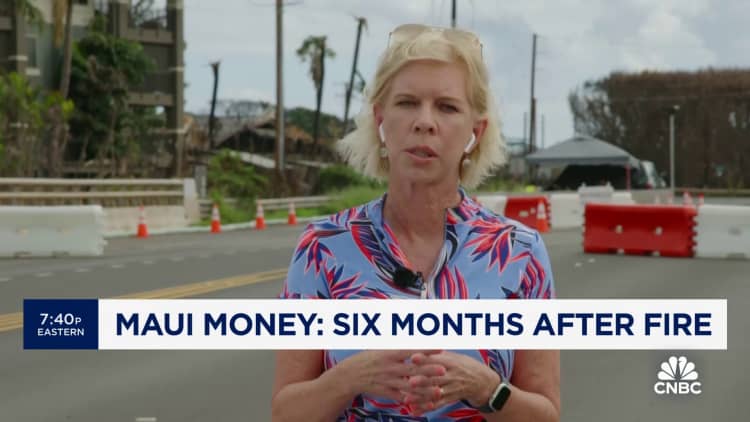BurnBot RX burns undesirable vegetation with out emitting plumes of smoke.
Lora Kolodny for CNBC
Last 12 months’s report warmth wave worsened drought and dry situations throughout the globe, a very calamitous state of affairs for California, which has seen 13 of the state’s 20 most harmful wildfires in historical past get away since 2017.
In South San Francisco, a small startup is engaged on a high-tech method to wildfire prevention.
Anukool Lakhina and Waleed “Lee” Haddad based BurnBot in 2022 to develop robotics and remote-controlled automobiles that may munch up and burn away invasive crops or different dry vegetation that may gas fires if left fallow.
BurnBot has simply raised a $20 million funding spherical led by climate-focused ReGen Ventures, for enlargement, hiring, and to develop new machines that may traverse steeper hills and get into tighter areas.
Before BurnBot, firefighters and land homeowners had to make use of costly, time-consuming and extra harmful choices like grazing away the vegetation (usually with goats), burning it, making use of herbicides or eradicating vegetation mechanically with a mixture of gear and handbook labor.
“The sort of traditional way to do a prescribed burn is with drip torches, and that requires a large number of people,” mentioned Lakhina, BurnBot’s CEO. “A drip torch is like a diesel watering can. You go around, you drop diesel, then ignite it.”
Burnbot’s present mannequin, the RX, is a remote-operated car that appears a cross between an outsized Zamboni and a metal cooking vary with a set of fireplace extinguishers strapped to its again. Like different agricultural and building gear, the RX rolls ahead on tank-like tracks and wheels, which allow it to maneuver by tough fields.
Within the chambers of the RX are a number of rows of torches that emit blue flames, and modify the warmth ranges exactly to zap away undesirable vegetation or different fuels on the bottom beneath. The chambers of the BurnBot RX additionally lure and torch away the smoke that comes from burning vegetation, so it does not pollute the air in surrounding communities. When the torching is completed, the RX sprays water repeatedly to extinguish any remaining embers.
Inside the chambers of the BurnBot RX torches are lit to do the work of a prescribed burn.
Lora Kolodny for CNBC
Lakhina mentioned BurnBot’s programs might be put to make use of the place conventional managed burns will not work. For instance, drip torch burns produce a great deal of smoke, which is conductive sufficient it could intrude with the right functioning of energy strains or high-voltage gear. BurnBot’s machines can be utilized even beneath energy strains.
The firm is aiming to make each one who works in fireplace prevention 10 instances simpler than they had been with previous strategies, Lakhina mentioned.
Haddad, BurnBot’s chief expertise officer, famous that land is not at all times able to “receive fire” in a prescribed burn. So the corporate has programmed gear, which it procures from one other provider, to roll forward of the RX to crunch up the vegetation in an space of concern earlier than it is prepared for torching.
BurnBot plans to conduct a prescribed burn this Friday in San Diego, a undertaking for CalTrans, the state’s transportation company. It additionally plans for one more burn for Pacific Gas & Electric, the state’s main utility, in June.
PG&E spends upward of $1 billion on “vegetation management” annually. Kevin Johnson, who leads the corporate’s Wildfire Resilience Partnerships, mentioned PG&E is at all times “looking for opportunities to do this work safer, faster, cheaper and to be more environmentally friendly.”
BurnBot has already accomplished one demonstration of its managed burn machine beneath PG&E transmission strains.
Brice Muenzer, a battalion chief with CalFire in Monterey, California, mentioned huge fires within the state and all through the U.S. over the previous decade have been partly triggered and definitely exacerbated by overzealous elimination of smaller fires, together with ritual fires from indigenous communities.
“We removed fire from the ecosystem for the last 150 years and are living through that reality now,” the chief mentioned.
CalFire has labored with BurnBot personnel, machines and extra drones overhead, to create what’s referred to as a management line within the subject in a minimum of one location. Muenzer says the group hopes to do extra with the startup.
Creating a management line, or blacklining the land, entails firefighters strategically burning areas when the climate is calm and the place flames might be managed to create scars that can block different fires from leaping in and reaching areas with a lot of new materials to burn.
BurnBot cofounders (L-R) CTO Waleed “Lee” Haddad and CEO Anukool Lakhina
Lora Kolodny for CNBC
BurnBot goals to finally increase its operations past California, with places of work and fleets of its machines wherever vegetation administration is required and wildfire threat is highest.
“There are 50 million acres that the U.S. Forest Service has said need treatment every year and that’s just forest land,” mentioned Lakhina. In the U.S. there are 237 million acres that want remedy general. And grazing can price $1,000 an acre.”
Childrens’ health is at stake along with property and healthy forests, Lakhina added. According to the Harvard School of Public Health, wildfire smoke can be more toxic than air pollution from other sources, leading to more emergency room visits, especially for children who are exposed.
Because BurnBot offers greater precision than grazing, herbicides and mechanical removal, its systems should prove ecologically more beneficial as well, Haddad said. The BurnBot RX is able to help prevent the spread of seeds from invasive species, for example, without causing any of those species to develop resistance to an herbicide.
ReGen was joined in BurnBot’s funding round by investors including AmFam Ventures, which is the venture arm of an insurance company, Toyota Ventures, and earlier backers including robotics fund Pathbreaker, Convective Capital and Chris Sacca’s Lowercarbon Capital.
WATCH: Revisiting Maui six months after devastating wildfires

https://www.cnbc.com/2024/04/02/burnbot-raises-20-million-to-build-technology-for-wildfire-prevention.html


